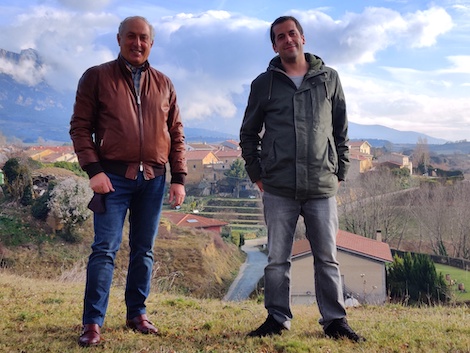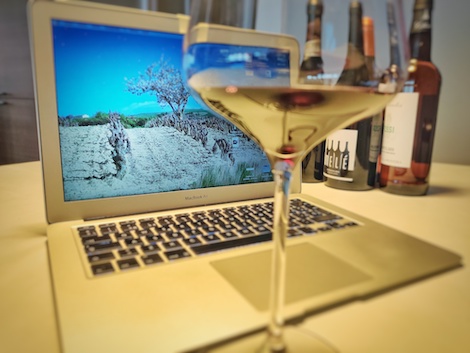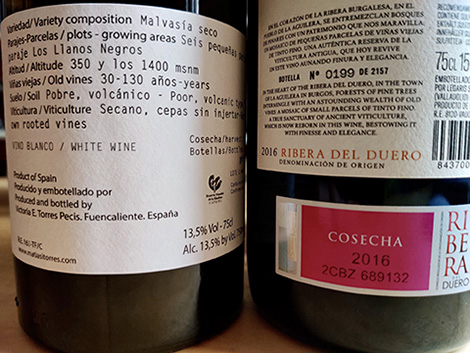Amaren: A family legacy and the search for wines with truth

Although he was a pioneer in bottling young cosechero wines, Luis Cañas never imagined that his name would become one of the most recognised in Rioja Alavesa or that it would travel halfway around the world printed on the bottles of wine produced in the family winery in Villabuena, his village.
Born in 1928 and witness to economic hardship and rationing, Luis never imagined that his work as a bricklayer in the extension of the now defunct Palesa cooperative in Samaniego would help to build a small part of Amaren, the winery that is a tribute to Ángeles Herrera, his wife and a pillar of the business until her death in 1997.
"Ángeles was not, as the cliché goes, the great woman who is always behind a great man," explains her son Juan Luis in the prologue to the book Luis Cañas, Labrador de un Sueño, written by Javier Pascual to mark the 90th birthday of the patriarch, who passed away in 2019. "My mother was the great woman who, side by side with my father, each contributing the best of themselves, helped to lay the firm foundations on which we stand today.”
The first Amaren wine (the mother's, in Basque), an old-vine Tempranillo, was born in 1995 seeking that modern Rioja style initiated by Marqués de Riscal with Barón de Chirel. The success of the wine and Juan Luis Cañas' desire to create a brand with its own personality, like his mother, were the reasons that led this Basque producer to purchase and renovate the old cooperative, barely two kilometres away from Luis Cañas' winery. Nowadays Amaren produces around 300,000 bottles, of which Ángeles de Amaren is its flagship wine.
"We have maintained the original concrete tanks, which is where everything is vinified in conjunction with the wooden vats, but we have improved them with temperature controls," explains Juan Luis. The winery, rebuilt following sustainability criteria, features the original 16th century cellar's old cellars. In it rest barrels of various sizes and amphorae storing the fruit of the conscientious work being done in the vineyards.
Old vineyards near the winery
Jon, Juan Luis' son, who started in the family business at the age of 26, has joined in the Amaren adventure. After two years working in the vineyards while studying oenology in Laguardia, Jon moved on to production and today, with 33 summers and lots of passion, he is in charge of transferring the character of those family vineyards to the bottle. Jon relies on the help of Rubén Jiménez, head of viticulture at Amaren and Luis Cañas, who is in charge of managing the 458 hectares of vineyards divided into 1,120 owned and leased plots. Of these, 70 hectares belong to Amaren.
Both Rubén, 43, and Jon emphasise that the vineyard is the cornerstone of Amaren. "We look for wines with truth, trying not to change what comes from the vines and bringing out the personality of the grapes and the vineyards we have.”
The distribution of the vineyards between the two brands was made based on their location. For Amaren, the vineyards were preferably bush vines over 15 years old and primarily centred in Samaniego. "There are a few exceptions such as the single-varietal Garnacha, which comes from a vineyard in Villabuena planted almost entirely with this variety, and the 100% Graciano, from over 100-year-old plots in Leza, or Amaren 60, which comes from vineyards in Leza, Samaniego and Villabuena since its first vintage. In any case, 90% of the vineyards are less than five kilometres from the winery and are on average 50 years old,” Rubén explains.
To take care of all this wine heritage, Amaren shares with Luis Cañas a veteran field team of 13 people, plus crews of workers such as the grape harvesters, who travel every year from Quesada in Jaén (southern Spain). They are very familiar with the plots of land and the pruning that is required.
Tending the vines is also the job of the growers from whom Amaren buys grapes. Both parties have a close relationship. "We want them to see us as viticultural advisors rather than as buyers. Although it wasn't possible this year due to the pandemic, we offer them training courses on respectful pruning systems, cluster thinning and phytosanitary products so that they only use them when necessary,” Rubén points out. "Fortunately, there are young growers; not all of them are old people. We believe that part of our responsibility as producers is to add value to the territory and offer a future to the young people here, so that it is profitable for them to stay and farm the vineyards. We demand good quality grapes, but we also pay well for them. If you pay €0.50 per kilo of grapes, the balance is broken.”
A landscape to be preserved
Caring for the territory also involves the recovery of the rich landscape and biodiversity of plots such as Tío Perico, a vineyard in Samaniego with views of the Sierra Cantabria mountain range. It is a picturesque place, with a large holm oak in one corner and stone slabs on the ground that break the lines of old goblet vines whose grapes are used for Amaren 60, the winery's most iconic wine.
The vineyard team use the quieter moments of the year to repair huts or dry stone walls such as those surrounding this and other properties, where insect hotels and drinking troughs for birds are installed. Rubén and his team also provide birdhouses and indigenous trees to grape suppliers to re-populate their vineyards, or prune almond trees to prevent mistletoe from devouring them. "For those of us who work in the countryside, the vineyard is our office and we take this incredible landscape of for granted. Fortunately, we are all becoming aware that it is essential to preserve it for our children and grandchildren,” says Rubén, who was an oenological consultant before his job here.
In 2016 Familia Luis Cañas launched a plan to have all its Rioja Alavesa vineyards herbicide-free by 2020, but Rubén acknowledges that this has not yet been achieved completely. "Having 50 hectares in 10 plots is relatively simple, but working with many growers and over 1,100 plots with narrow planting spacing that require a lot of manual work is really complicated. Some growers are still reluctant, others do not have the right tools such as an in-row weeder, but our aim is to completely abandon herbicides by the end of this year or by 2022 at the latest.”
Finding Benedicto
Having so many old vines, the Amaren team were aware of the wealth of varieties and clones on their vineyards, but a few years ago they decided to investigate further. Together with the Institute of Vine and Wine Sciences in Logroño, they identified 37 Benedicto vines, the mother of Tempranillo and practically extinct, and upwards of 30 varieties that have been on their land for at least 100 years, such as Mencía, Bobal, Xarel.lo, Parellada and other, lesser known varieties that were at risk of disappearing, such as Marufo, Morate and Garró. Once identified, the next step will be to recover these varieties and prevent genetic erosion with the planting this year of an experimental vineyard to preserve germplasm —according to Familia Luis Cañas, it will be the most comprehensive in the DOCa Rioja.
The viticultural potential of some of these varieties is very interesting in the face of climate change, Rubén says. They have carried out microvinifications with five of them —Bobal is vinified separately since 2016 "to learn”— and they eventually hope to do the same with all 30 varieties. "I'm very excited about Benedicto and I think it's going to bring us much joy," explains the vineyard manager of Familia Luis Cañas. "In 2019 we produced the first 17 bottles of Benedicto —they probably were the first in history because in the old days all the varieties were blended together. We discovered that Benedicto has intense fruit aromas in tune with the area. It produces a wine with high colour and alcohol (14%) and the acidity is good with a pH value of 3.5. It does not lack freshness and has pleasant and refreshing tannins, but we will have to study it well and see how it behaves.”
The recovery of this varietal and clonal diversity will also soon be a reality at Carboneras, a 3,000 m2 south-facing slope that laid abandoned until 2017, when the Cañas family acquired it. "We are going to replant it this month with a selection of 50 Graciano clones from our oldest vineyards, and in the higher areas we are going to grow old-vine Malvasía. We want to preserve this white variety, build on our typicity and leave this legacy for the next generations to come.”
Single varietal wines
Malvasía and Graciano are, together with Garnacha, the three varieties that Amaren vinifies separately in its limited collection of single-varietal wines. Only 1,700 litres of Malvasía are produced and the wine sees no oak ageing. Despite the apparent simplicity of the process, Jon Cañas confesses that it is one of Amaren's most complicated wines. "For this wine we only take the darkest, more sun-exposed Malvasía grapes, which are almost red in colour. In addition to the challenge of finding these grapes, Malvasía is very oxidative and it demands a lot of work for it to withstand 22 months in a concrete egg to achieve that combination of persistence, body and fruit,” Jon explains.
The Garnacha, which comes from a selection of vineyards between 100 and 120 years old in Villabuena, only 600 litres are made, and then only in exceptional vintages such as 2014 or 2020, which is the one currently being aged in the cellar. The style is agile, with notes of black pepper, sour fruit and great freshness. Is this the style of wine he is looking for? " In the past, our wines had a bit more extraction and the oak barrels provided notes of cedar and cigar box, but I think this style we're making now is the future", says Jon. "When we release this wine in five years' time, we want it to have that fruit."
Although he has brought freshness and unbridled passion to the project, Jon shies away from the limelight and always speaks collectively about the work at Amaren, pointing out that the wines are made by everyone, from the vineyard team to the sales staff. "Everyone" also includes his father Juan Luis, with whom one senses that there is a relationship of mutual respect but also healthy doses of laughter and humour.
"I challenge him on many things so that he doesn't think everything is easy; I want him to question himself," says Juan Luis. "And I think he does, because there are many days when he doesn't even sleep because he's so hooked." Shortly after telling us this, Juan Luis expresses his doubts about Jon's idea to bottle the 2019 Graciano without undergoing malolactic fermentation. "Graciano in this area has high acidity, low pH and high alcohol so bacteria just won't do their job on their own," argues Jon, while Juan Luis smiles and observes that his strategy is bearing fruit. "Why are we going to force malolactic fermentation when the wine doesn't want to do it? Wine is not mathematics, aita (dad, in Basque). You have to be vigilant and help when it's needed.”
Viñedos Singulares
At present, they have no village wines labelled as such, but they do make single vineyard wines, a category they are investing a great deal in. They have been granted the Viñedo Singular category in several vineyards, although they feel that the minimum age of 35 years set by the Regulatory Council is too little. "If the cut-off age had been set at 50-60 years, this category might have had greater value," says Rubén Jiménez. "We farm some 350 plots that could qualify for Viñedo Singular. But for this category we are not only looking for age; we also seek vineyards situated in an attractive setting and wines with character."
Amaren's first single vineyard wine was El Regollar. It was born in 2014 because they saw that this 0.8 hectare plot had a distinct personality thanks to the iron-rich shallow soils planted in 1920 and located in the upper part of Villabuena. "It was the only wine we used to tread because there is not much of it, but I told Jon that his grandfather and I used to tread everything with our feet at the beginning and we left the trasnocho (draining of the grapes after the first treading), as it used to be done in the villages, and now he treads all the wines,” points out Juan Luis.
With its wild orchids, aromatic herbs, fig, olive and peach trees, old vines and layered vines emerging amongst the bedrock, El Regollar, worked by mule, is truly postcard-perfect, and in fact it is one of the vineyards that can be visited on the wine tours hosted by the winery. El Regollar is a field blend of seven varieties, white and red. For Jon, it is a "complex but silky red, with good fruit and no trace of oak,” which is the style of wines that Amaren generally aims to produce. "I don't make wines with their sale in mind; I make them because of the personality of the vineyard.”
In addition to El Cristo de Samaniego, which comes from a vineyard planted in 1980 at an elevation of 685 metres, and Viña Chelus, from an old vineyard with a blend of varieties planted in the same village, the fourth single vineyard wine on the market is Carraquintana. It comes from three adjoining terraces of just over one hectare in Leza, planted between 1930 and 1962 mostly to Tempranillo but there are also almost 300 Malvasía plants that contribute seductive floral notes to the wine. "In this plot we pick all the varieties together so we have to ensure that they ripen at the same time," Jon explains. "It's a lot of work for three barrels, but I'm thrilled with the result. Behind its apparent fragility and the rose flower notes, there is a wine with structure, complexity and great length.”
R&D and whites with ageing potential
Aside from the dozen wines that Amaren has on its portfolio, the duo Jon-Rubén is always ready to take on new challenges. In a corner of the winery, work will soon begin on what will be Familia Luis Cañas' R&D+I department, where they will be able to test everything that comes out of the experimental vineyard, but in the meantime they are vinifying individual plots, working with varieties such as a Calagraño separately or ageing a refreshing, straightforward Garnacha in a clay amphora. Last year they filled four barrels from separate plots in Samaniego and Villabuena —but with completely different expressions— in order to make a great white for cellaring. "At the end of the year we will taste the four barrels to see which one we like best. The resulting wine will be called Begoña, after my mother," adds Jon.
Josemi Zubia, marketing director of Familia Luis Cañas, points out that Juan Luis Cañas was one of the first in the area to revive the production of white wines in 1989 and, continuing with his father's entrepreneurial spirit, he was also one of the first to make a barrel-fermented white wine. Despite the family's pioneering nature, who also owns Dominio de Cair in Ribera del Duero, and the vast resources they devote to their vineyards, Josemi believes that the winery does not get the recognition it deserves. "Perhaps Juan Luis has this image of a wine businessman and people are not aware that he is always at the winery and constantly fussing over the vineyards. This perception is something we have to try to improve.”
Do you think critics treat you fairly?, I ask. "Our guiding principle is to make wines that are meant to be enjoyed. That is our motivation. Sometimes critics don't take into account those producers who are doing well and prefer to discover new things. But who farms sustainably over 1,100 plots with the strict controls we maintain here? Maybe 10 producers in the whole of Rioja?,” asks Juan Luis. "Some people say to me: 'your wines are everywhere' and it seems that this is annoying for some. And I say: we make 1.5 million bottles of Luis Cañas Crianza, not six million. The thing is that we have a fantastic distribution network that manages to get us to the places where we have to be, but in fact we still operate with monthly allocations. We have decided not to grow any more because the vineyard, the winery and the staff are in balance. Now we have to focus on doing things better. And really have fun with special things like Amaren's top wines.”

Yolanda Ortiz de Arri
A journalist with over 25 years' experience in national and international media. WSET3, wine educator and translator
NEWSLETTER
Join our community of Spanish wine lovers






